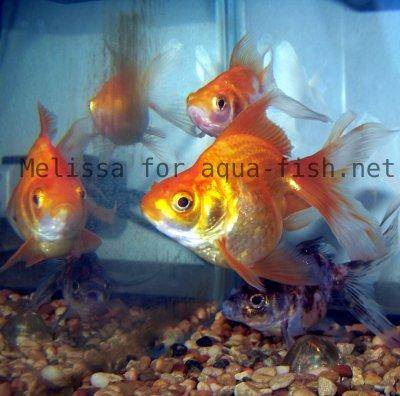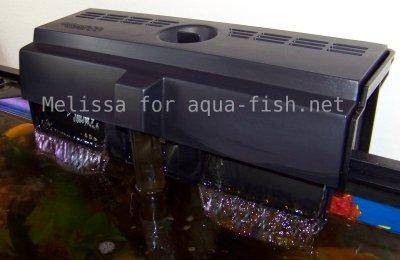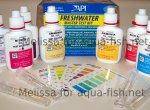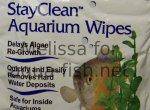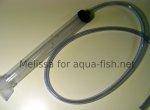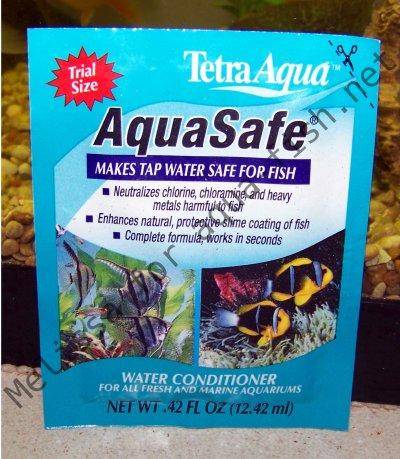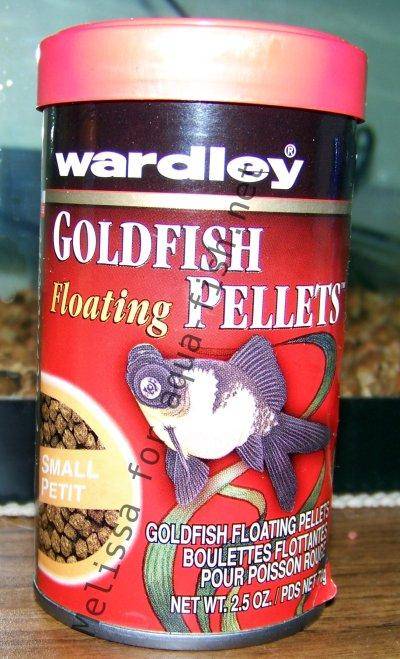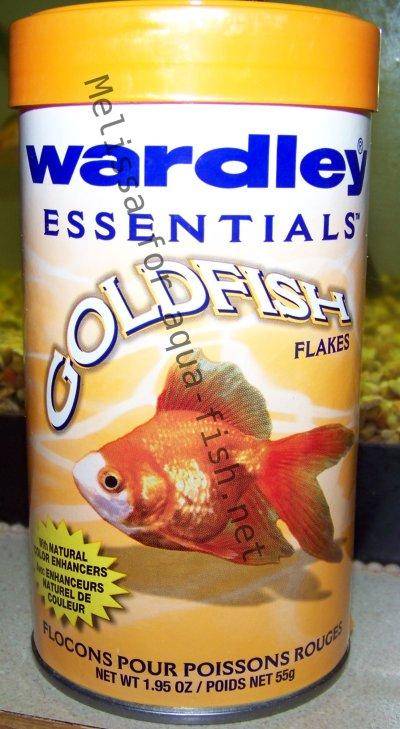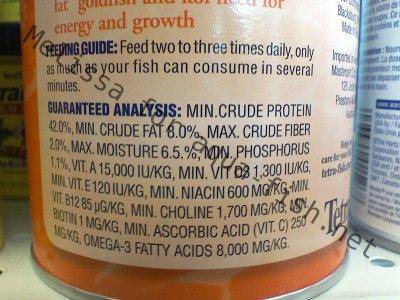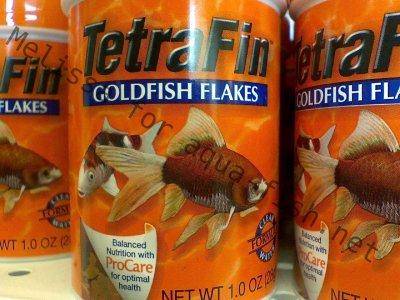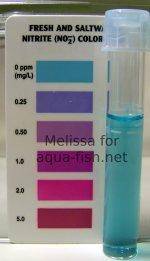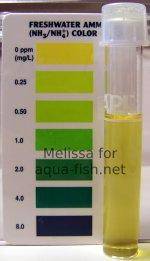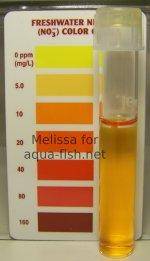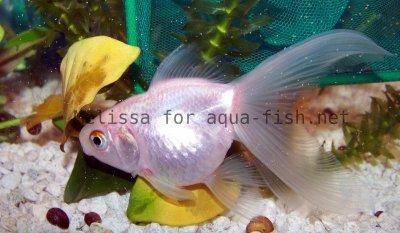How to keep Goldfish and keep water at high quality level
Quick links - Answers
Brief Description
This page is devoted to water quality in a Goldfish tank. You're welcome to share your experiences or ask questions in case they haven't been answered on this page! Use a form at the bottom of this page for this purpose, please. You should also visit these pages: Goldfish - Care, Types and Pond Fife with FORUM, Carassius auratus auratus profile with FORUM, Goldfish FAQ, Goldfish diseases.
The quality of the water in a goldfish aquarium determines the health of the goldfish in it. To start with, it is important to set up an aquarium with fresh, clean water, and then the challenge is to maintain the quality of the water.
Setting Up an Aquarium with High Quality Water:
When setting up a new aquarium it is important to first start with a large, clean aquarium. Goldfish have the potential to grow very large for aquarium fish and will thrive in a pond or very large aquarium of no less than 75 gallons of water. Never use detergents or any type of cleanser to get the inside of your fish tank clean. Scrubbing any fish equipment with a rough sponge or brush should work just fine. Chemicals of any kind should never be used in a fish tank unless they are specifically made for aquarium use, in which case they should be used sparingly, only as directed, and only as a last resort.
Filtration:
Mechanical filtration
Is where the debris and wastes of the fish and plants are filtered out of the water. Since goldfish are messy fish that produce excessive amounts of waste this is a very crucial part of filtration process. Remember that fish are trapped in their environment with all of their wastes and no where to hide from their own pollutants. Imagine how bad their water would be without the constant extraction of the waste particles. With mechanical filtration the water is passed through a filter where all the debris is extracted out and the clean water is flows back into the aquarium.Biological filtration
Is a very crucial element of the aquarium. This filtration system is made up of different types of bacteria with the very specific job of converting harmful chemicals such as ammonia and nitrite into a less harmful chemical known as nitrate. Without the presence of the biological filter your goldfish will suffer from the presence of these toxic and dangerous substances inevitably leading to death.Chemical filtration
Utilizes activated carbon to extract chemicals from the water. The activated carbon attracts impurities and contaminants in the water and work by absorbing them thus preventing them from circulating back into the water. Carbon works to extract chemicals from the water so it needs to be removed if you plan to medicate the aquarium for any reason. Otherwise the carbon filter will also work by extracting the medication from the aquarium water. Carbon filtration is not effective in removing salt and minerals from the water.
Different Filtration Options:
Canister filters
Provide very strong mechanical filtration for maximum efficiency. The canister sits either behind or beneath the aquarium with tubes for extracting and replacing water. This type of filtration device is very effective in filtering debris and wastes from the water so it is the ideal method of filtration when housing really messy fish such as goldfish.Under gravel filters
Are slow flowing filters that sit just beneath a thin layer of gravel. They are not very effective in filtering out debris and waste because of where they are located and also they lack the powerful suction of the canister filter. These filters are inexpensive and they work just fine in aquariums with very few and very clean fish but they are not all that effective when it comes to messy goldfish. Under gravel filters would not be able to provide clean, quality goldfish water.Power filters
Are highly effective and easy to use. They typically hang on the back of the aquarium with a tube siphoning water into the container where the debris and chemicals are filtered out of the water. The water passes through a sponge with nitrifying bacteria before spilling back into the aquarium. Because goldfish are extremely messy, it would be a great idea to use a power filter that is meant to handle a higher volume of water than your aquarium can hold. This will ensure high quality water for your goldfish.
It is very important to have a properly working filtration system running in your aquarium long before you ever add any fish. This allows time for the biological filter to establish itself and control all of the ammonia and nitrite levels.
Aquarium Water Maintenance:
Routine aquarium maintenance is so important to the health and well-being of goldfish or any fish. Testing aquarium water for pH, chemicals and hardness will help to detect problems before they escalate into an out of control incident. A simple, adhesive thermometer attached to the outside of the aquarium will help you keep track of the water temperature to ensure your goldfish are not too hot or too cold. Regular cleaning of the inside of the aquarium can be done to minimize algae growth while performing frequent partial water changes to remove chemicals and wastes. These are all crucial elements for optimal quality goldfish water.
- Owning a master test kit is an essential part of maintaining excellent water quality. Aquarium Pharmaceuticals sells a freshwater master test kit that provides all you need to test pH, high-range pH, ammonia, nitrites and nitrate levels. By knowing the chemical and pH levels of your aquarium you can better maintain the quality of the water for your goldfish.
- Water Changes should be done frequently, ideally once a week. It is important to do only partial water changes because it does not require the removal of the goldfish from the aquarium which can cause too much stress. Another reason for performing partial water changes is because complete water changes will endanger the colony of beneficial bacteria and that can lead to toxic levels of ammonia in the aquarium.
- Water siphons are available to making water changes easier than ever. Some water siphons work better than others but all of them function basically the same way. A siphon is meant to suction the old dirty water up and out of the aquarium. The Gravel Vac is a type of siphon whose purpose is to suction debris and waste from within the gravel without actually sucking up the gravel. These siphons are conveniently made with a self-starting function which may take a little bit of effort to start, but it sure beats a mouthful of aquarium water when trying to create suction the old fashioned way. An easier to use siphon is the Python No Spill Clean N’ Fill which can be a bit more expensive but well worth it if you have a large aquarium. No more buckets of filthy water splashing around. This siphon hooks onto a water faucet and has the ability to drain and fill the aquarium with virtually no effort. Because goldfish are so messy and therefore require frequent partial water changes, it would be a great idea to invest in a siphon that will make your aquarium cleaning quick and easy.
- Water Conditioners are available online and in aquarium retail stores to condition the tap water and make it suitable to add to the fish tank. Goldfish, like most other fish are sensitive to the chlorine that is most likely present in the tap water in your area. Water conditioners contain ingredients that help neutralize the chlorine so it does not harm the fish. They also detoxify heavy metals and contain aloe vera which helps to minimize the effects of injury and stress on your goldfish. Water conditioners will help to replace a goldfish’s slime coat which serves as a protective layer against diseases and parasites in the water. Aquarium Pharmaceuticals Tap Water Conditioner and Tetra Aqua Safe Aquarium Water Conditioner are both comparable products both in cost as well as effectiveness. The determining factor might be the sale price of the product or a preference in brand name. Either one will help maintain the quality of water in a goldfish aquarium.
- Algae Control can be done in a number of ways. Controlling the amount of sunlight or artificial light hitting the aquarium is the easiest and often very effective way of controlling algae growth. Limiting the presence of nitrates in the aquarium water will also help to keep algae growth to a minimum because algae thrives in high nitrate conditions. Scrapers and scrubbers can be used to clear the algae growing on most aquarium surfaces. There is a magnetic scrubbing device that is used to clean algae without having to stick your entire arm in the aquarium water. The only downfall with this method is that it only works on the glass and not on ornaments or substrate. This is because one side of the magnet has to be placed on the outside of the glass and dragged along to cause the inside magnet to move back and forth in a scrubbing motion. Aquarium wipes are specially designed to be used safely on the inside of the aquarium. Not only are they supposed to remove algae growing on aquarium surfaces, these wipes are also meant to slow down the re-growth of algae. If algae is really a problem there are products like Algone which is not only supposed to inhibit algae growth, it also helps to eliminate harmful chemicals and clear up cloudy water.
Goldfish Digestion:
Goldfish are messy fish due to their lack of a stomach. When a goldfish eats, the food is crushed in their mouth and sent straight to their digestive tract. Since there is no stomach to break down the food their nutrients must be quickly extracted from their food before it exits the goldfish’s intestines. Because food needs a lot of time to be broken down in the body, most of their food ends up as waste, thus giving the goldfish the reputation of being messy. One common mistake with goldfish is overfeeding. It is very important not to feed goldfish more than they can eat within a few minutes. Any leftover food floating in the water will cause cloudiness and chemical buildups. Those are both very bad when trying to achieve high quality goldfish water.
Certain types of goldfish food are considered better than others based on how efficiently the fish can digest it. The quicker a goldfish can digest its food the more vitamins and nutrients the fish will absorb before the rest is expelled as waste. The more completely a goldfish can digest its tasty morsels of food, the less waste you can expect to pollute the water in the fish tank. So if you carefully choose good foods for your goldfish you can expect your aquarium water to remain cleaner for longer. Do not be afraid to compare food labels while you are in your local pet store buying goldfish food. Foods high in carbohydrates are good for goldfish because they are quicker to digest than proteins, although it is a good idea to provide a good amount of veggies in their diet to aid in the digestive process.
Aquarium Chiller:
Goldfish are coldwater fish which means they thrive in lower water temperatures than most other tropical fish. A goldfish can survive in water temperatures as cold as 50°F and as warm as 77°F. The optimum water temperature to raise goldfish in is somewhere between 68-75°F. In warmer months it might be difficult to control the water temperatures without the use of an aquarium chiller. Such a device can be found online or in aquarium retail stores that specialize in marine aquarium or pond supplies. Chillers can be fairly expensive when compared to the cost of aquarium heaters, but they are definitely worth it if it preserves the health and well being of your goldfish. Aquarium chillers can be set to the specific temperatures needed for your goldfish. They extract heat from the aquarium water releasing it into the atmosphere. It is not uncommon for the area around an aquarium chiller to get pretty warm so it is a good idea to place the chiller in a well aerated space where nothing is touching it.
The Nitrogen Cycle:
It takes as little as 3 weeks to establish the nitrogen cycle but it can take as long as 8 weeks. The water quality and health of your goldfish will depend greatly on your understanding of the nitrogen cycle when starting a new aquarium.
Ammonia is a chemical that is highly toxic to fish even if it present in the smallest amount. Fish excrete ammonia into their surroundings through their gills and feces. It is also a product of decaying plant matter and uneaten fish food. Nitrite is another chemical that is also very toxic for fish if there are detectable amounts present in the water. Nitrite becomes present in the aquarium as the ammonia is metabolized by nitrifying bacteria. In a well established aquarium there is one group of bacteria whose job is to take ammonia and convert it into nitrite. There will then be a second set of bacteria present whose job will be to convert that nitrite into nitrate. It is ok for there to be small amounts of nitrates present in the aquarium water but in order to maintain quality water for your goldfish, partial water changes should be done roughly once a week.
Fishless Cycling:
Fishless cycling is a method of developing nitrifying bacteria without sacrificing the first few fish to initiate the process. In order to start the development of ammonia metabolizing bacteria there must first be ammonia present. With the filtration system in place and running, and the aquarium heater set at 80-85°F, 5 drops of pure ammonia is added to the aquarium water. Using the ammonia test from a master test kit, test the ammonia levels in the aquarium each day. After each test is done add 5 more drops of ammonia to the aquarium. When the ammonia metabolizing bacteria colony is established you will notice a sudden drop of ammonia when conducting the ammonia test. It is important to keep adding ammonia in order to sustain the presence of this bacteria type. Now start testing for nitrites each day all the while adding the same daily dose of ammonia. As you have seen the detectable ammonia levels drop you will suddenly see the detectable nitrite levels drop. This indicates the presence of all the nitrifying bacteria you will need to start a successful goldfish aquarium. At this point you can stop adding ammonia and conduct your first partial water change to remove some of the nitrates produced by the bacterial colony. Test the water once more to verify it is of great quality and then the goldfish can be added to the aquarium to live long and happy lives.







